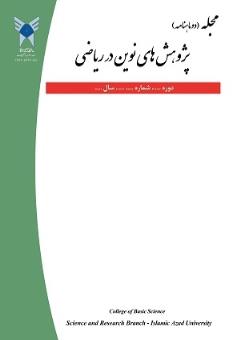مدلسازی تصفیه پساب های صنعتی بر پایه شبکه عصبی مصنوعی و مدل آماری رگرسیون لجستیک
محورهای موضوعی : آنالیز عددی
سیدرحیم صانعی فرد
1
*
![]() ,
فاطمه قنبری
2
,
احمد جعفریان
3
,
فاطمه قنبری
2
,
احمد جعفریان
3
1 - گروه ریاضی، واحد ارومیه، دانشگاه آزاد اسلامی، ارومیه، ایران.
2 - گروه شیمی، واحد مهاباد، دانشگاه آزاد اسلامی، مهاباد، ایران.
3 - گروه ریاضی، واحد ارومیه، دانشگاه آزاد اسلامی، ارومیه، ایران.
کلید واژه: Water pollution, statistical logistic regression, Mathematical Modeling, Neural Network, hybrid neural network,
چکیده مقاله :
با توجه به اهمیت شناسایی آلاینده های صنعتی و یافتن راهکار هایی برای مدیریت وکنترل آن در جهت حفظ بقا، سلامت انسان و محیط زیست، دسترسی به مدل هایی که بتواند با دقت بالا این مهم را پیش بینی کند نقش مهمی به لحاظ اقتصادی و زمانی دارد. در این تحقیق سه مدل مختلف برای پیش بینی فرایند حذف آلاینده ی مالاشیت سبز با ویژگی جهش زایی و سرطان زایی از پساب های صنعتی ارائه گردیده و یافته های حاصل مقایسه شدند. هدف اصلی در این پژوهش مقایسه دقت مدل های مختلف شبکه عصبی و رگرسیون لجستیک و مدل هوشمند ترکیبی شبکه عصبی مصنوعی و رگرسیون لجستیک (ANN-LR ) جهت پیش بینی درصد حذف آلاینده ی مالاشیت سبز از پسا ب های صنعتی است تا بتوان یکی از آنها را به عنوان روش بهینه انتخاب و استفاده نمود. متغیر های مستقل در هر سه مدل شبکه عصبی، رگرسیون لجستیک و مدل ترکیبی ANN و LR شامل مقداراولیه نانو کامپوزیت پلی آنیلین پوشش داده شده روی خاکستر پوسته گندم (PANI/WHA)، غلظت اولیه مالاشیت سبز، شدت اشعه ی یو وی (UV light) و زمان پرتو افشانی و متغیر وابسته در مدل شبکه عصبی درصد حذف آلاینده ی مالاشیت سبز می باشد. مقایسه ی نتایج پیش بینی، توسط مدل طراحی شده و داده های بررسی شده ثابت می کند که استفاده ازمدل ترکیبی شبکه عصبی مصنوعی و رگرسیون لجستیک روشی ارزشمند برای پیش بینی عملکرد حذف ماده سمّی مالاشیت سبز از پساب های صنعتی با بیشترین بازده وکمترین خطا می باشد.
One of the most important and fundamental factors in the life of living things is water. Therefore, water pollution is a major environmental problem and prevent water pollution and providing smart methods for water treatment is so important. Equipping engineering sciences with intelligent tools and artificial intelligence in the diagnose quality of wastewater treatments can reduce the errors of the methods. This paper presents a simple and hybrid neural network with statistical logistic regression method for modelling of the output quality of wastewater treatment. The proposed intelligent method plays an important role in the quality of wastewater treatment and can be used by artificial intelligence researchers and environmental engineers. Comparison of the predicted results by simple neural network and hybrid one showed that the efficiency of the hybrid model and it is suitable for our purpose. results of research proved that the new method has the highest efficiency with minimum errors.
[1] M. A., BEHNAJADY, N. MODIRSHAHLA and F. GHANBARY, “A kinetic model for the decolorization of C.I. Acid Yellow 23 by Fenton process,” J. of Hazar. Mate., vol.148, no. 3, pp. 98-102, 2007.
[2] N. DANESHVAR, A. R. KHATAEE and N. JAFARZADEH,”The use of artificial neural networks (ANN) for modeling of decolorization of textile dye solution containing C. I. Basic Yellow 28 by electrocoagulation process,” J. of Hazar. Mate., vol 137, no. 4,pp. 1788-1795, 2006.
[3] F. GHANBARY and A. JAFARIAN, “Polyaniline/wheat Husk Ash Nanocomposite Preparation and Modeling Its Removal Activity with an Artificial Neural Network,” Chiang Mai J. of Science, vol. 42, no. 9, pp. 1-12, 2015.
[4] J. WAN, M. HUANG, Y. MA and X.SUN, ”Prediction of effluent quality of a paper mill wastewater treatment using an adaptive network-based fuzzy inference system,” App. Soft Comp., vol. 11, no. 3, pp. 323-34, 2011.
[5] S. POMMIER, D. CHENU, M. QUINTARD and X. LEFEBVRE, “A logistic model for the prediction of the influence of water on the solid waste methanization in landfills,” Biotech. and bioeng., vol. 97, no. 6, pp. 473-482, 2007.
[6] I. MICHAEL, A. PANAGI, L. A. IOANNOU and Z. FRONTISTIS, ”Utilizing solar energy for the purification of olive mill wastewater using a pilot-scale photocatalytic reactor after coagulation-flocculation,” J. of Water res.,vol. 60, no. 7, pp. 28-40, 2014.
[7] H. HONGGUI, and Y. LI, “A fuzzy neural network approach for online fault detection in waste water treatment process,” Comp. & Elec. Eng., vol.40, no.12, pp. 2216-2226, 2014.
[8] M. S. NASR, M. A. MOUSTAFA, H. A. SEIF and G. E. KOBROSY, “Application of Artificial Neural Network (ANN) for the prediction of EL-AGAMY wastewater treatment plant performance-EGYPT,” Alex. Eng. J., vol. 51, no.25, pp. 37-43, 2012.
[9] T. R. NEELAKANTAN and G. M. BRION, “Neural network modelling of Cryptosporidium and Giardia concentrations in the Delaware River,” Water Sci. & Tech. vol. 43, no. 23, pp. 125-132, 2001.
[10] U. GOVINDARAJ and S. RAO, “Artificial neural networks in hydrologic applications,” J. of Hydro. Eng., vol. 52, no. 42, pp. 124-137, 2000.
[11] H. R. MAIER and G. C. DANDY, “Neural networks for the prediction and forecasting of water resources variables: a review of modelling issues and applications,” Env. modelling & soft., vol. 15, no. 12, pp. 101-124, 2000.
[12] J. ZURADA, “Introduction to Artificial Neural Systems,” West Publishing, 1992.
[13] S. HAYKIN, “Neural networks:a comprehensive foundation,” Prentice Hall., New Jersey, USA, 1999.
[14] Y. X. ZHANG, “Artificial neural networks based on principal component analysis input selection for clinical pattern recognition analysis,” Talanta, vol.73, no.8, pp. 68-75, 2007.
[15] F. GHANBARY, N. MODIRSHAHLA, M. KHOSRAVI and M. A. BEHNAJADY, “Synthesis of TiO2nanoparticles in different thermal conditions and modeling its photocatalytic activity with artificial neural network,” j. of Env. sciences, vol. 24, no. 21, pp. 750-756, 2012.

